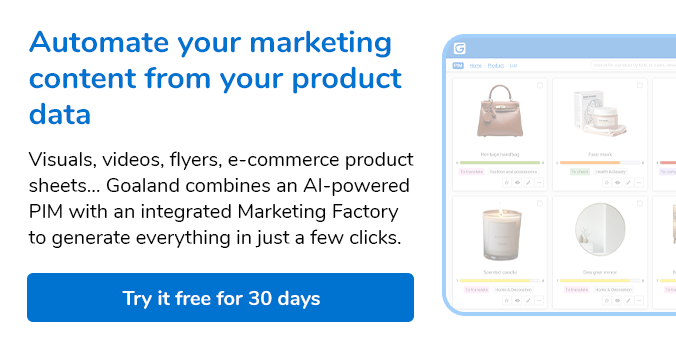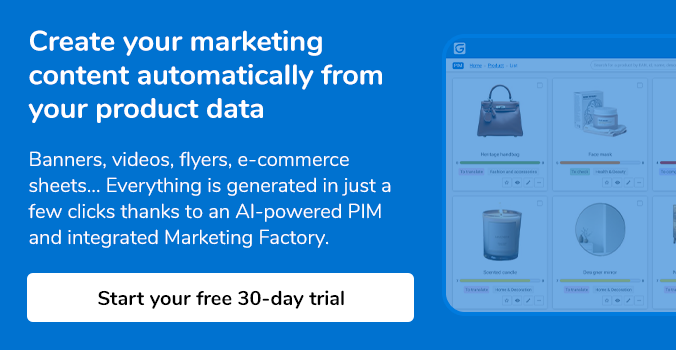It has become essential to consider product information matters for any business wishing to remain competitive. 98% of consumers1 are likely to abandon a purchase if the product information is incorrect or incomplete.
To handle these issues effectively, many businesses are now using PIM (Product Information Management) software. Finding the right PIM will add a powerful component to your Marketing and Sales strategy.
However, choosing a PIM has become a real challenge as the industry is dynamic and constantly evolving. According to a survey by MarketsandMarkets, the PIM market was worth 7 billion2 dollars in 2019.
To pick the best possible PIM for your needs, you need to study and compare each of the top programs on the market, using a pertinent analyses grid.
Check out the 10 essential features of an efficient and modern PIM.
#1. User-friendly and intuitive interface
PIM becomes the company's central product reference source. Used daily by the Product and Marketing teams, its interface needs to be designed carefully to be clear, simple and user friendly. It must also allow users to get on board quickly: easy familiarization, intuitive navigation, easy to use… A user-friendly focus (User eXperience or UX) is essential to get the most from any PIM solution.
#2. Modelling and customization
Each company is different: data organization, management procedures, technical and economical restrictions… Organizing working processes and product data can be extremely complex: management of suppliers, brands, ranges, collections, distributers, customers…
It's best to choose a fully customizable PIM: free organization of product or all other data, personalization of management screens, organization of user rights and roles… When configured properly, PIM can help you manage a product catalog depending on your business needs and model information on several different levels.
#3. Search and navigation
To find information quickly in a sizeable repository, users need to rely on quick and advanced search functionalities (full-text indexation, multi-criteria filters, organization in multiple formats…) and simple and intuitive navigation features.
#4. Calculated fields
An advanced PIM should be capable of processing product data automatically. Just like formulas in Excel spreadsheets, a good PIM needs to integrate calculation management features to manipulate data dynamically and to carry out automatic operations: calculation of reduced prices, currency conversions, formatting of information, data chains, creation of tables, conditional displays, automatic alerts…
#5. Managing digital assets

For Product and Marketing teams, Digital Asset Management (DAM) software is essential for dealing with digital resources: storing and sorting thousands of files (photos, video and sound files, marketing contents…), exporting in different formats, managing royalties, restrictions…
To link digital assets to product information, your PIM must integrate Digital Asset Management features and/or be equipped with connectors enabling it to interact with the company's DAM.
#6. Managing contexts
In the context of Product eXperience Management (PXM), Product and Marketing teams must be equipped to adjust product data to make it fit the context. PIM software's context management features allow them to store and distribute information adapted to each channel, target and/or country, on all shopping channels.
#7. Translation management

Translation management features are essential when managing a multilingual environment. They allow you to optimize the process of translating all contents: centralization of translation projects, monitoring translation progress, validation of translated materials…
#8. Workflow and user rights
Workflow and validation features should be considered carefully when choosing a PIM solution. This is a means of improving the quality of product information.
In a company, several contributors can be involved in enhancing product information: brands, sites, units, customers… To ensure that this collaboration is efficient, it is essential to have good control and validation features, to coordinate the work between several contributors. A powerful workflow engine organizes user rights and roles to ensure that each contributor can, depending on their rights, check and correct product information before delivering to the selling channels.
#9. Supervision
PIM should provide optimal visibility of the progress of each product page. Progress analysis features monitor the correct input of data. Ideally your PIM solution should be capable of managing different progress rules depending on the various sales channels to control the quality of the information sent. This enables users to act quickly and effectively to complete or correct any missing data or mistakes.
#10. Integration in the information system
PIM (Product Information Management) software must be at the core of the company's Information System (IS). To achieve this, PIM must provide features facilitating interaction with other software solutions: ERP (Enterprise Resource Planning), CRM (Customer Relationship Management), files in various formats (Excel, XML, Json…), eCommerce sites, Marketplaces…
A PIM solution should therefore be equipped with customizable import and export features, a webservice API for inter-application exchanges or connectors towards different applications (CMS, eCommerce platforms, Marketplaces, automatic page layout tools…).
For the PIM to integrate seamlessly into your IS, you need a team of experts to accompany you through each phase of the project. They must have a full understanding of your business-related issues and your constraints, and a thorough knowledge of their own software solution. They must always be prepared to provide pertinent solutions to your needs: customization of the platform, import and export procedures, setting up connectors, specific developments… They are also in charge of change management for working methods and guaranteeing their sustainability: analysis of the existing situation, project scoping, internal communication, workshop facilitation… This high-level support is what guarantees the success of a PIM project.
1Chrum, A.10 Stats That Prove the Importance of Product Content for E-commerce [Infographic].
2 MarketsandMarketsTM INC. Product Information Management Market worth $11.4 billion by 2024.







